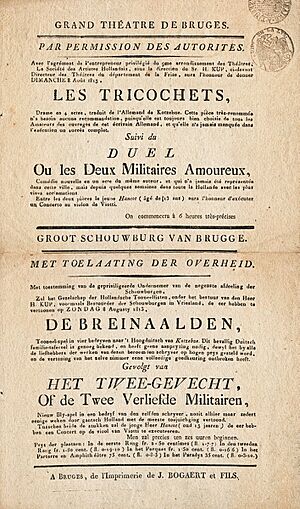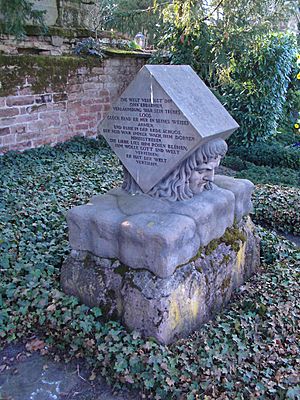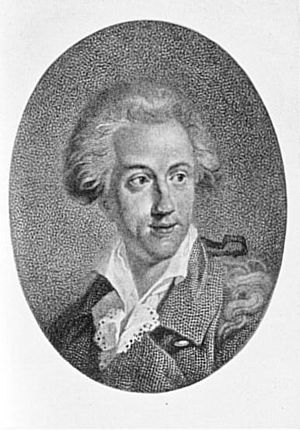August von Kotzebue facts for kids
Quick facts for kids
August von Kotzebue
|
|
|---|---|
 |
|
| Born | 3 May 1761 Weimar, Saxe-Weimar, Holy Roman Empire |
| Died | 23 March 1819 (aged 57) Mannheim, Grand Duchy of Baden, German Confederation |
| Resting place | Mannheim |
| Occupation | Writer |
| Language | German |
| Alma mater | University of Duisburg |

August Friedrich Ferdinand von Kotzebue (born May 3, 1761 – died March 23, 1819) was a famous German writer and playwright. He also worked as a consul for Russia in different countries.
In 1817, one of Kotzebue's books was burned during a student festival called the Wartburg festival. He was later murdered in 1819 by Karl Ludwig Sand. Sand was a student who was part of a nationalist group. This murder led to strict new rules called the Carlsbad Decrees in 1819. These rules limited freedom of the press and academic freedom in Germany.
Contents
Life of August von Kotzebue
Kotzebue was born in Weimar, a city in Germany. His family was well-known. He went to school in Weimar, where his uncle, a writer, was one of his teachers. When he was 15, he even acted in a play with the famous writer Goethe.
In 1777, at age 16, he started studying law at the University of Jena. He finished his studies at the University of Duisburg in 1780. After that, he worked as a lawyer in Weimar.
Working in Russia
Kotzebue later moved to Russia. He became a secretary to the Governor General of Saint Petersburg. In 1783, he got a job as a judge in Reval (now Tallinn, Estonia). There, he married the daughter of a Russian general.
In 1785, he was given a noble title. He became the head of the local government in Governorate of Estonia, which was part of the Russian Empire.
Early Writing Success
While in Reval, Kotzebue started writing. His novels, like The Sorrows of the Ortenberg Family (1785), became popular. His plays, such as Adelheid von Wulfingen (1789) and Misanthropy and Repentance (1790), were even more successful. Many people liked his early works.
However, a play he wrote in 1790, Doctor Bahrdt with the Iron Brow, caused problems. It was a satire that made fun of someone. Even though Kotzebue denied writing it, this play made some people think he was dishonest.
Moving Around Europe
After his first wife died in 1790, Kotzebue left his job in Russia. He lived for a while in Paris and Mainz. In 1795, he bought an estate near Reval and focused on writing. In just a few years, he published many stories and over twenty plays. Many of his plays were translated into other languages.
In 1798, he became a playwright for the court theatre in Vienna. But he soon left because he disagreed with the actors. He then went back to his hometown of Weimar. However, he didn't get along with Goethe and openly criticized the romantic style of writing. This made his position in Weimar difficult.
Exile and Return
In 1800, Kotzebue decided to go back to Saint Petersburg. But on his way, he was arrested at the border. People thought he might be a Jacobin, a supporter of radical political change. He was sent to Tobolsk in Siberia.
Luckily, he had written a comedy that pleased Emperor Paul I of Russia. He was soon brought back and given land in Vooru. He was also made the director of the German theater in Saint Petersburg. Kotzebue wrote about this strange time in his life in his book The strangest Year of my Life.
After Emperor Paul I was murdered in 1801, Kotzebue returned to Germany. He tried to join the writers in Weimar but couldn't. So, he moved to Berlin. There, he edited a journal called Der Freimutige.
When Napoleon won the Battle of Jena-Auerstedt in 1806, Kotzebue fled back to Russia. From his safe estate in Estonia, he wrote many articles criticizing Napoleon Bonaparte. These were published in his own journals.
In 1816, he started working for Russia's foreign affairs department. A year later, he was sent to Germany as a consul general for Russia. Some people thought he was a spy. While this idea was popular for a long time, it has since been shown that he mostly reported on public information. However, he was definitely a strong supporter of Russia in Germany.
Assassination of Kotzebue
Kotzebue published a weekly journal in Weimar. In it, he often made fun of Germans who wanted more freedom and new political systems. Because of this, many nationalist liberals disliked him.
One of these people was Karl Ludwig Sand, a theology student. Sand decided to kill Kotzebue. On March 18, 1819, Kotzebue had just moved to Mannheim with his family. Sand attacked him at his house.
Sand was arrested and later recovered from his injuries. At his trial, he claimed Kotzebue was an enemy of the German people. But he was found guilty of murder and was executed later that year.
Kotzebue's assassination gave Prince Metternich a reason to create the Carlsbad Decrees. These laws placed more limits on universities and the press in Germany.
Kotzebue's Works
Even though many critics didn't like his work, Kotzebue was one of the most popular writers of his time. He believed people were jealous of his fame. He was politically conservative and had a broad view of the world. He also spoke out against hatred towards Jewish people by student nationalists.
In 1812, the famous composer Beethoven asked Kotzebue to write the story for an opera. This opera was never finished. However, Beethoven did write music for two of Kotzebue's plays: The Ruins of Athens and King Stephen.
Besides his plays, Kotzebue wrote several history books. One of them, History of the German Empires, was burned by nationalist students at the 1817 Wartburg Festival. Karl Ludwig Sand, who later killed Kotzebue, was at this festival.
Some of his autobiographical writings are still read today. These include My Flight to Paris in the Winter of 1790 and The strangest Year of my Life.
As a playwright, he wrote over 200 plays. They were very popular not just in Germany but all over Europe. His success came from his ability to create exciting and interesting situations in his plays. His comedies, like Der Wildfang and Die deutschen Kleinstädter, are considered his best. They show funny parts of German life.
His play Menschenhass und Reue (known as The Stranger in English) was a huge success. It helped make melodrama a very popular type of play in the 1800s.
Legacy

August von Kotzebue had 18 children. Some of his notable children include Karl von Kotzebue (a diplomat) and the explorer Otto von Kotzebue.
Kotzebue Street in Kalamaja, Tallinn, Estonia, is named after him and his family members who lived there.
The book Rejected Addresses (1812) includes a funny parody of Kotzebue's play The Stranger.
Beethoven's "Turkish March" was originally written for Kotzebue's play The Ruins of Athens. It became one of Beethoven's most famous pieces.
The writer Jane Austen saw one of Kotzebue's plays in 1799. In her novel Mansfield Park, she used a version of another of his plays, Das Kind der Liebe.
See also
 In Spanish: August von Kotzebue para niños
In Spanish: August von Kotzebue para niños



